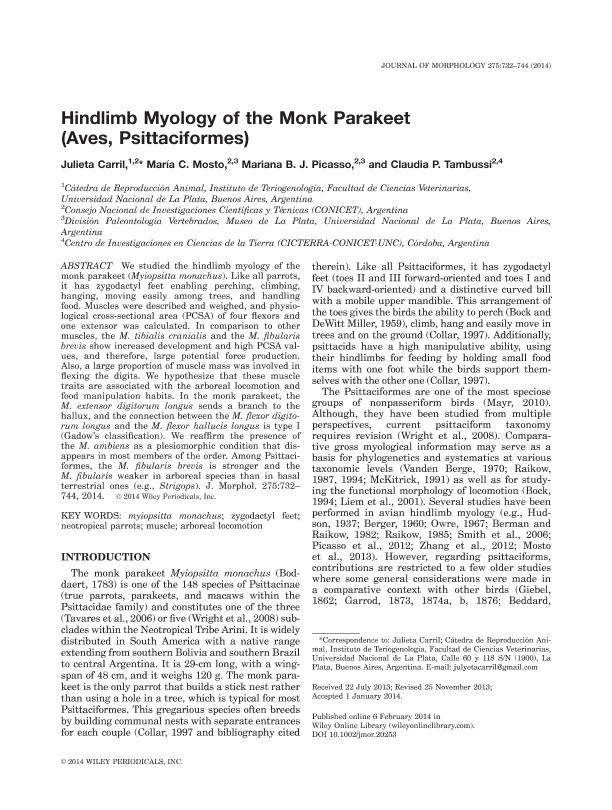Artículo
Hindlimb Myology of the Monk Parakeet (Aves, Psittaciformes)
Carril, Julieta ; Mosto, María Clelia
; Mosto, María Clelia ; Picasso, Mariana Beatriz Julieta
; Picasso, Mariana Beatriz Julieta ; Tambussi, Claudia Patricia
; Tambussi, Claudia Patricia
 ; Mosto, María Clelia
; Mosto, María Clelia ; Picasso, Mariana Beatriz Julieta
; Picasso, Mariana Beatriz Julieta ; Tambussi, Claudia Patricia
; Tambussi, Claudia Patricia
Fecha de publicación:
01/2014
Editorial:
Wiley-liss, Div John Wiley & Sons Inc
Revista:
Journal of Morphology
ISSN:
0362-2525
Idioma:
Inglés
Tipo de recurso:
Artículo publicado
Clasificación temática:
Resumen
We studied the hindlimb myology of the monk parakeet (Myiopsitta monachus). Like all parrots, it has zygodactyl feet enabling perching, climbing, hanging, moving easily among trees, and handling food. Muscles were described and weighed, and physiological cross-sectional area (PCSA) of four flexors and one extensor was calculated. In comparison to other muscles, the M. tibialis cranialis and the M. fibularis brevis show increased development and high PCSA values, and therefore, large potential force production. Also, a large proportion of muscle mass was involved in flexing the digits. We hypothesize that these muscle traits are associated with the arboreal locomotion and food manipulation habits. In the monk parakeet, the M. extensor digitorum longus sends a branch to the hallux, and the connection between the M. flexor digitorum longus and the M. flexor hallucis longus is type I (Gadow’s classification). We reaffirm the presence of the M. ambiens as a plesiomorphic condition that disappears in most members of the order. Among Psittaciformes, the M. fibularis brevis is stronger and the M. fibularis weaker in arboreal species than in basal terrestrial ones (e.g., Strigops).
Archivos asociados
Licencia
Identificadores
Colecciones
Articulos(CCT - LA PLATA)
Articulos de CTRO.CIENTIFICO TECNOL.CONICET - LA PLATA
Articulos de CTRO.CIENTIFICO TECNOL.CONICET - LA PLATA
Citación
Carril, Julieta; Mosto, María Clelia; Picasso, Mariana Beatriz Julieta; Tambussi, Claudia Patricia; Hindlimb Myology of the Monk Parakeet (Aves, Psittaciformes); Wiley-liss, Div John Wiley & Sons Inc; Journal of Morphology; 275; 1-2014; 732-744
Compartir
Altmétricas



